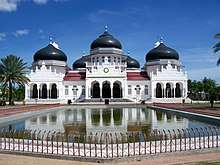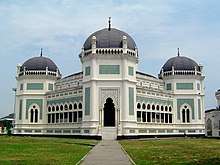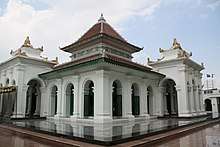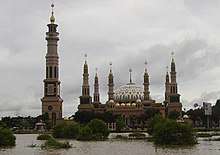Kasunyatan Mosque
Kasunyatan Mosque (Indonesia Masjid Kasunyatan) is a small mosque in Kasunyatan village, Banten, Indonesia. Established between 1570 and 1596[2] it is one of the oldest mosques in Indonesia. The mosque is located in close proximity to the ruins of Old Banten, and functioned as a 16th-century center of Islamic learning in Banten. The mosque received a heritage status during the Dutch colonial period in 1932. Its status today is unknown.
| Kasunyatan Mosque | |
|---|---|
Masjid Kasunyatan | |
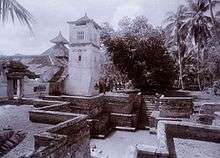 The water well of Kasunyatan Mosque in the 1920s | |
| Religion | |
| Affiliation | Islam |
| Province | Banten |
| Status | Active |
| Location | |
| Location | Kasunyatan, Serang Regency, Banten, Indonesia |
| Geographic coordinates | 6.050932°S 106.157169°E |
| Architecture | |
| Type | Mosque |
| Style | Eclectic Javanese, Portuguese, Hinduism |
| Founder | Kyai Dukuh (Pangeran Kasunyatan)[1] |
| Completed | Between 1570 and 1596[2] |
| Specifications | |
| Direction of façade | east |
| Length | 11.50 metres (37.7 ft)[3] |
| Width | 11.30 metres (37.1 ft)[3] |
| Minaret(s) | 1 |
| Minaret height | 10.82 metres (35.5 ft)[3] |
| Materials | brick, clay tiles |
History
Kasunyatan Mosque is one of several mosques located around Old Banten; the other mosques are the Great Mosque of Banten and Masjid Kanari. There are other remnants of mosques in the Old Banten, such as the tower of the ruined Masjid Pecinan Tinggi, the already demolished mosque of the Kraton Kaibon, and ruins of Koja Mosque.[4] It is located outside the walled city of Surosowan Kraton, Old Banten.[5]
Kasunyatan Mosque was founded by Kyai Dukuh, the leader of the Islamic school of thought in Banten and the teacher of the Sultan Maulana Muhammad.[1] Kyai Dukuh, who received the title Pangeran Kasunyatan, gave his name to the village and to the mosque.[1] Kasunyatan Mosque was built as a prayer facility for the community of Islamic scholars in the Kasunyatan Village.[6] There are differing opinions about the foundation date, but the mosque was established during the reign of Maulana Yusuf, somewhere between 1570 to 1596.[2]
The mosque complex
The mosque is located in the village of Kasunyatan, 500 meter south of Kraton Kaibon in the Old Banten.
The mosque complex is surrounded by walls with three main gates on the west, south, and east. The western gate is the main entrance for the tombs on the north of the mosque complex. The western gate also acts as a boundary between the northern tomb area and the eastern tomb area. The southern gate provide entrance to the eastern tomb area. Both the western and the southern gate features a simple curving form with ornaments.[3] The eastern gate is the main entrance to the mosque complex. It is 7.10 meter in length and 3.10 in height. It features the Semar Tinandhu decoration, showing Hindu-Javanese influence.[3]
At the center of the mosque complex is the main mosque. The main mosque consists of a main prayer hall, surrounded by three "porch" (serambi) to the north, east, and south. The layout of the main prayer hall is square-shaped, roughly 11.30 x 11.50 meter. The roof is built in a typical Javanese mosque architecture with three-tiers, supported by four main posts (saka guru) and topped with a terracota mustaka (roof top decoration).[3] The main prayer hall's interior is constructed of white-washed brick. Two doors provide entrance to the north and south of the hall. The mihrab is located to the west of the main prayer hall and contains motifs of false columns and plant-like arabesque on top, reminiscent of the kala makara motif of classical candi architecture.[7] The serambi of Kasunyatan Mosque is enclosed with wall, which is unusual for Javanese mosque architecture which usually has its serambi wall-less like a porch. The northern serambi kept a bedug and an inscription which marked the year the Kasunyatan Mosque received its heritage status in 1932 by Soeria Nata Atmaja. The eastern serambi contains 18 tombs, including the tomb of Ratu Asiyah and Syekh Abdul Syukur Putra. The southern serambi contains 5 tombs.[7]
The mosque features a minaret, an unusual feature in Javanese mosque architecture. The minaret is located on the southwest corner of the mosque. It is an 11 meter tower of white-washed brick, consists of three floors and topped with a clay roof tiles topped with a terracotta mustaka.[3] The minaret shows Portuguese influence.[8] There is a similarity between this minaret and the minaret of the ruined Masjid Pecinan Tinggi in Old Banten.[9]
To the west of the mosque complex is a 1.7 meter deep stepwell with a pond of 3.8 meter deep used to perform ablution. Normally, a stepwell is located in the front of a mosque, however the stepwell of the Kasunyatan Mosque is located at the back (west) of the mosque, being closer to a former river (now a lake) to the west of the mosque.[3][10] This water well is now covered with corrugated steel roof.
See also
| Wikimedia Commons has media related to Kasunyatan Mosque. |
References
- Djajadiningrat 1983, p. 39.
- Nasution 1994, p. 11.
- Daniel Iriyani 2013.
- Nasution 1994, p. 3.
- Nasution 1994, p. 9.
- Nasution 1994, p. 10.
- Nasution 1994, pp. 17-9.
- Tawalinuddin Haris 2011, p. 15.
- Nasution 1994, pp. 4-5.
- Nasution 1994, pp. 21-2.
Works cited
- Daniel Iriyani (July 23, 2013). "Masjid Kasunyatan - Serang, Banten". Kebudayaan Indonesia. Kebudayaan Indonesia. Archived from the original on November 12, 2015. Retrieved November 13, 2015.
- Djajadiningrat, Hoesein (1983). Tinjauan Kritis Tentang Sadjarah Banten [Critical Review on the History of Banten] (in Indonesian). Jakarta: Djambatan. ISBN 9789790758476.
- Nasution, Isman Pratama (1994). "Mesjid Kasunyatan" [Kasunyatan Mosque] (PDF) (in Indonesian). Depok: FIB UI. Archived from the original (PDF) on November 14, 2015. Retrieved November 14, 2015. Cite journal requires
|journal=(help) - Tawalinuddin Haris, ed. (2011). Mesjid-mesjid Bersejarah di Jakarta [Historic Mosques of Jakarta] (in Indonesian). Jakarta: DIVARO. ISBN 9789790758476.
